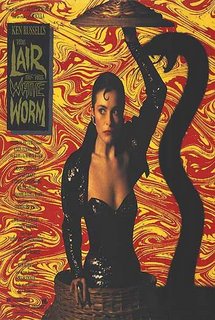
Director: Ken Russell
Release Date: 1988
contains spoilers
There are many films which find themselves on vampire filmographies, but some are not about vampires, nor contain a vampire. One film that has caused much debate is “The Lair of the White Worm”.
The film is based on a novella by Bram Stoker of which you can say two things. Firstly, unlike “Dracula”, it has not stood the test of time and you can check that for yourself here.
Secondly you can fairly much state that it is not about a vampire, rather it is about a giant worm.
The film itself is more ambiguous. Our attention must focus on Lady Sylvia Marsh (Amanda Donohoe) who is most certainly a vamp (as the picture above indicates), but is she a vampire?

Well she has retractable fangs (as seen extended in the second picture), but this is more to do with her being a snake creature, as is her spitting of poison. She has a violent reaction to Christian symbols, yet this is explained by the fact that she worships the White Worm and sees Christianity as a false religion. Many argue that she can walk in daylight, which precludes her from being a vampire; this is an unfair proposal as Stoker’s Dracula was also able to walk in daylight.
Being a snake creature, one wonders whether there are any other snake women in myth. The answer is yes, the lamia. But what is a lamia?
“The ancient Greeks believed that the Lamia was a vampire who stole little children to drink their blood. She was portrayed as a snake-like creature with female head and breasts. Usually female, but sometimes referred to as a male or a hermaphrodite. “
"Lamia." Encyclopedia Mythica from Encyclopedia Mythica Online.
http://www.pantheon.org/articles/l/lamia.html
[Accessed March 11, 2006].
Yet the description offered does not match Lady Sylvia Marsh. It is interesting that the above quoted entry mentions hermaphrodites as, in the film, cave paintings are discovered of a hermaphrodite and, later, Lady Marsh wears an enormous phallus making herself such a creature. But this is a transformation from woman to hermaphrodite through props, can a Lamia naturally take the form of a woman? Later in the entry, however, we see the following:
"In Lamia and other Poems (1820), the English poet John Keats writes about Lamia too. In this version, based on the information he found in Anatomy of Melancholy of the 1600s, Lamia has the ability to change herself into a beautiful young woman. Here she assumes a human form to win a man's love."
"Lamia." Encyclopedia Mythica from Encyclopedia Mythica Online.
http://www.pantheon.org/articles/l/lamia.html
[Accessed March 11, 2006].
It is clear that some feel the lamia to be a vampire of sorts, but for me the tell as to whether the lamia in the movie is a vampire is the fact that she is able to spread her condition. P.C. Erny (Paul Brooke) is turned into a creature such as Marsh, complete with fangs. His death, by sundial through the eye, is reminiscent of “Le Masque du Demon” (196o) and the fact that the vampires in that movie are killed with a needle to the eye.
To me “Lair if the White Worm” is not only a great (if a little kitsch) movie, by a great director, but it is a vampire movie – albeit a rather novel one. However, I am sure that it is a subject that will continue to generate debate.
The imdb page is here.
EDIT: 22/6/18... Confession, I can't actually believe I missed this. Tonight I was watching the UK Blu-ray release of the film and picked up on a line that stated categorically that the venom caused a form of vampirism. Case closed, this is definitively a vampire film, that line showing that the filmmakers certainly did have vampires in mind.
On DVD @ Amazon US
On DVD @ Amazon UK
Saturday, March 11, 2006
Vamp or not? Lair of the White Worm
Posted by
Taliesin_ttlg
at
7:18 AM
![]()
Labels: lamia, snake vampire, vampire
Subscribe to:
Post Comments (Atom)
















2 comments:
Just saw it and throughout I was also thinking; are these creatures vampires? They have a few of the common tropes like fangs, immortality and an infectious bite. But the defining characteristic of a vampire is feeding on blood (or possibly life force).
Only late in the movie did I get the impression that was what these creatures were actually after. But it's the last scene that confirms it. The newly turned Angus clearly looks towards his friend as sustenance.
I will be, sometimes, a lot more liberal with my thought on whether something is 'Vamp or Not?' - a trope, not feeding, but from vampirism and defining in the film might push me across. What I haven't put in the article is that some commentators (Twitchell being a prime example) class Lamia's as vampires without question - I will question. In this case there was enough for me (and take the point re the sustenance at the end).
I re-watched this on Blu-ray very recently and that led to the edit in the text iro the dialogue
Post a Comment